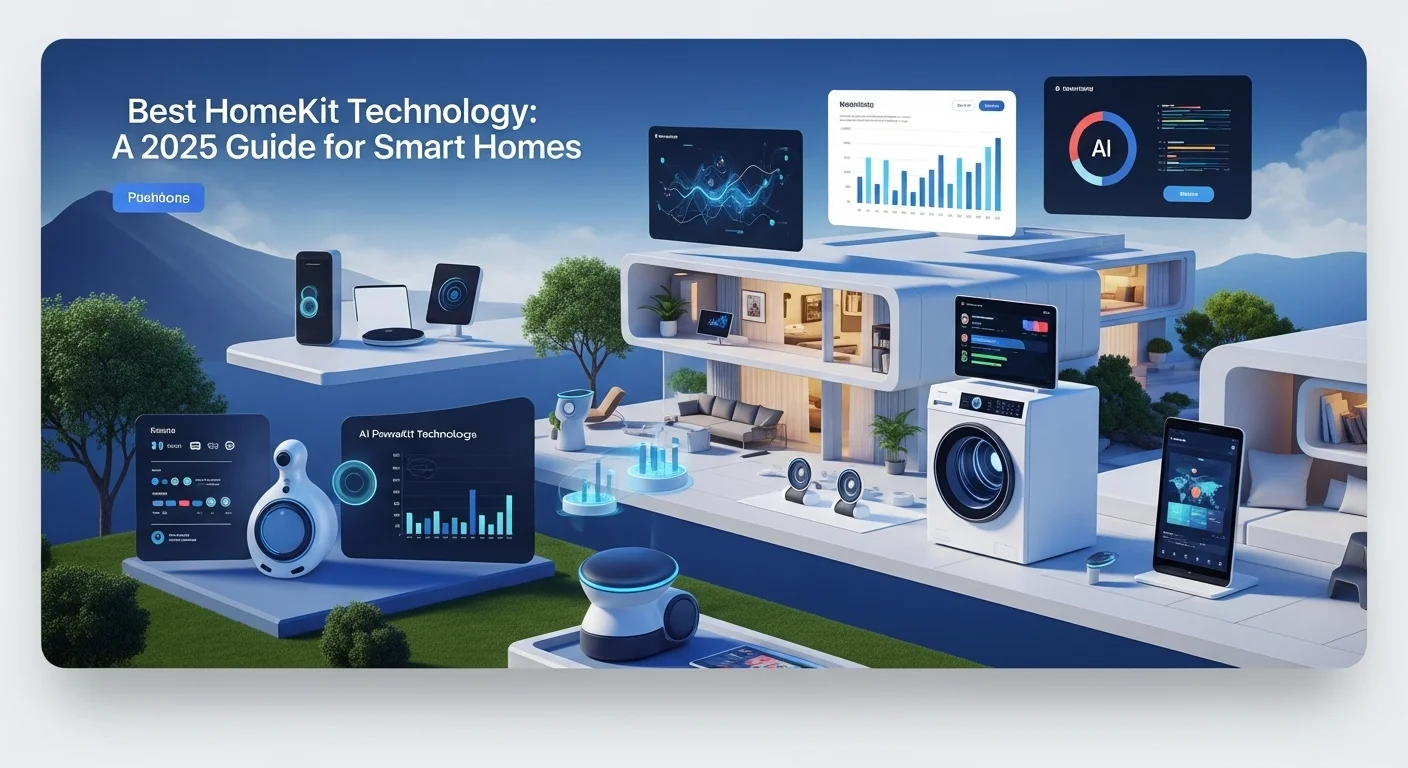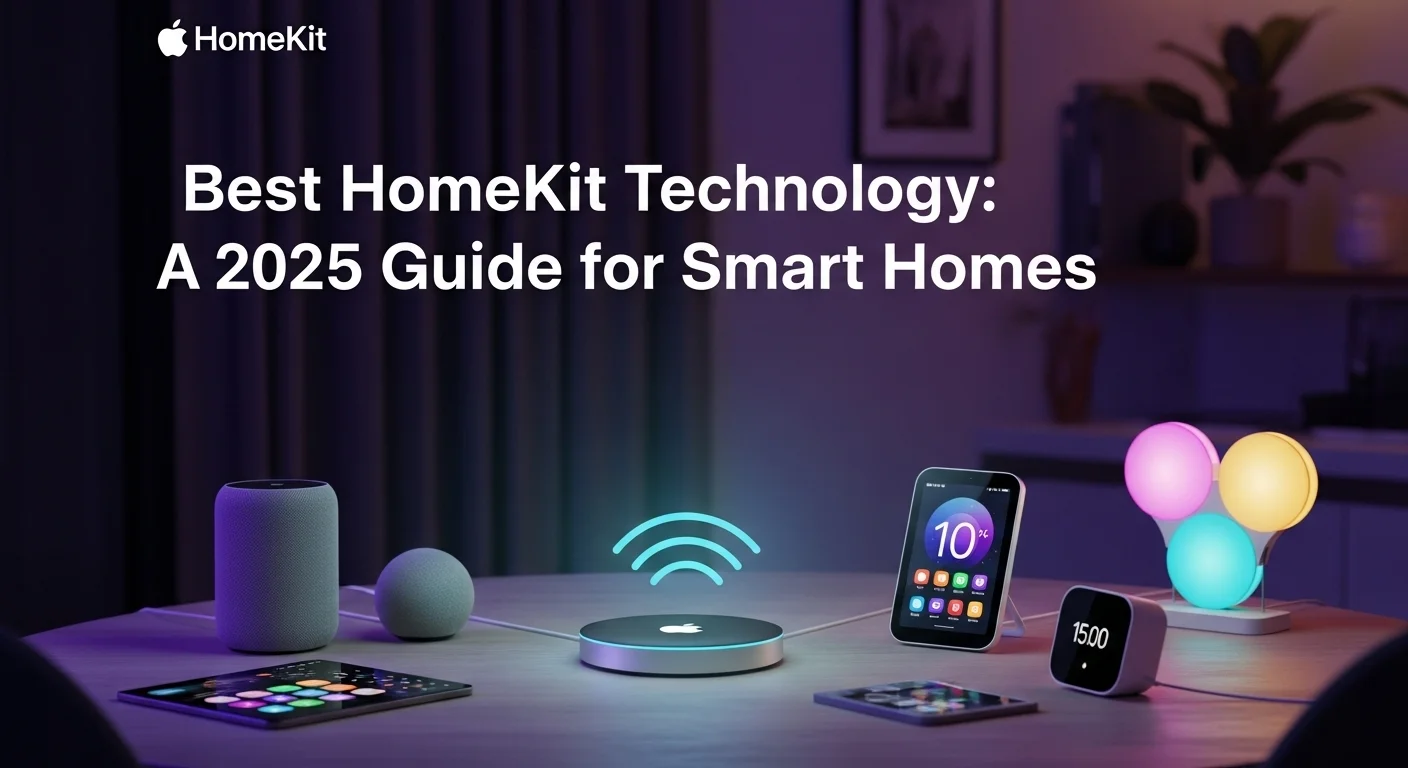Apple HomeKit Explained: My Ultimate 2025 Guide to a Smarter Home

Executive Summary
For years, I've helped people navigate the often-confusing world of smart home gadgets that just don't want to talk to each other. That's where I've found Apple's HomeKit to be a breath of fresh air. It's not just another app; it's the solid foundation that holds your smart home together, with a relentless focus on security and privacy. Whether you're a tech lover like me, dreaming of the perfect connected home, or a business owner looking for smart, efficient solutions, HomeKit has something valuable to offer. In this guide, I'll share my hands-on experience, from picking the best smart lights to setting up automations that actually make your life easier.
Table of Contents
- What is Apple HomeKit, Really?
- The Core Principles I Trust
- How It All Works: Hubs, Accessories, and the Home App
- Beyond the Home: HomeKit for Business
What is Apple HomeKit, Really?
In the wild west of the Internet of Things (IoT), where every device seems to have its own app and rules, a few platforms have tried to bring some order. In my experience, Apple's HomeKit stands head and shoulders above the rest when it comes to security, privacy, and just working smoothly within the Apple world. Let's be clear: HomeKit isn't a single product you can buy. It's a powerful and secure framework built right into your iPhone, iPad, Mac, and Apple TV. This framework is the magic that lets smart devices from hundreds of different brands communicate with each other and with you, all through one simple and secure app: the Apple Home app. The importance of this can't be overstated. It solves the biggest headaches of the smart home: devices not working together, scary security holes, and overly complicated setups. By creating this unified standard, Apple has built an ecosystem where I can confidently tell my clients to invest in great HomeKit products, knowing they will simply work together.
The Core Principles I Trust
To really get why I'm such a proponent of HomeKit, you have to understand what it's built on:
- Security: This is non-negotiable for me, and it's paramount in HomeKit's design. Any device that wants that 'Works with Apple Home' badge has to go through a strict approval process that includes end-to-end encryption. Think of it like a private, secret conversation between your iPhone and your lightbulb that no one else can listen in on—not even Apple. This extends to features I use all the time, like HomeKit Secure Video, which smartly analyzes camera footage on your own devices in your home before storing it securely in iCloud. Your private moments stay private.
- Privacy: This goes hand-in-hand with security and privacy. Apple’s business isn’t about selling your data. This means that information about your daily routines—when your lights turn on, if your door is locked, whether you're home—is never used for advertising. For me and many others, this is a massive reason to choose the HomeKit ecosystem over others.
- Local Control: Many HomeKit commands and automations happen locally, right inside your home on your Home Hub. This is a game-changer. It means your commands are faster and more reliable because they don't always need to travel to a server on the internet and back. Even if your internet goes down, many of your automations will still work. It's a key part of what makes the system so robust.
- Interoperability: This is the whole point. HomeKit makes devices from different companies play nicely together. You can grab the best smart lights from Philips Hue, a thermostat from Ecobee, and a lock from Schlage, and make them all work in harmony. For instance, I have a 'Good Night' scene that, with one tap, turns off every light in the house, lowers the thermostat, and locks the front door. That's true smart home convenience.
How It All Works: Hubs, Accessories, and the Home App
The HomeKit setup is beautifully simple. Your command center is the Home app on your Apple devices. The 'accessories' are your smart gadgets—the bulbs, switches, cameras, and sensors. The vital piece that connects it all for remote control and automation is a Home Hub. This can be a HomePod, HomePod mini, or an Apple TV. This device stays in your home and acts as a secure bridge to control your accessories when you're away. It's also the brain that runs your automations, making sure your 'Welcome Home' scene triggers reliably as you pull into the driveway. The setup process itself is something I always rave about. Most great HomeKit products have a simple code you scan with the Home app. Just scan it, and the device is securely added to your home. It’s that easy, which makes it welcoming for people just starting their smart home journey.
Beyond the Home: HomeKit for Business
While we often think of HomeKit for our houses, its potential in the business world is huge. I've seen small businesses, boutique hotels, and property managers use HomeKit to create incredibly effective and secure automation systems. Imagine an office where the last person to leave can say, 'Hey Siri, lock up,' and all the lights turn off, the thermostat dials back to save energy, and the security system arms itself. This isn't just cool; it's a real money-saver. In a hotel, guest rooms can be fitted with HomeKit, allowing guests to control their environment from an in-room iPad, offering a truly premium experience. For home builders, pre-installing a solid HomeKit system with smart lighting, locks, and climate control is becoming a major selling point. We're moving from the 'smart home as a novelty' to the 'smart home as essential,' and HomeKit is the perfect backbone for that shift.

My Go-To HomeKit Gear for Your Home and Business
Getting into Apple HomeKit means exploring a whole world of amazing products. For anyone, from the dedicated tech enthusiast to a business looking for efficiency, knowing what's out there is the first step. Here's my personal breakdown of the best HomeKit products I recommend time and again, both for personal and professional setups.
Navigating the Categories of HomeKit Accessories
The real power of HomeKit is in the variety and quality of devices you can connect to it. Apple holds a high bar for security and performance, so you can generally trust the products you find.
1. Smart Lighting: Where Every Smart Home Begins
Lighting is the classic entry point to the smart home, and for good reason. It's practical, makes a huge visual difference, and opens the door to countless automations. The market for HomeKit smart lights is fantastic.
- Philips Hue: I've been using Hue for years, and its reliability is rock-solid. It's often called the gold standard for a reason. While it traditionally uses a small 'Hue Bridge' connected to your router, I've found this is what makes the system so dependable. The color reproduction is beautiful and the app integration with HomeKit is seamless. For any business, that reliability is pure gold.
- Nanoleaf: If you want to add some personality, Nanoleaf is my top pick. They're famous for their modular light panels, but they also make some of the best HomeKit bulbs and light strips out there. Many of their new products use Thread, a mesh network that makes your devices respond almost instantly. I love using their unique designs to create feature lighting in homes or modern offices.
- LIFX: LIFX lights are known for being incredibly bright with stunningly vivid colors. They connect directly to your Wi-Fi, which simplifies setup, but I always recommend a strong Wi-Fi network if you plan on using a lot of them. Their light strips that can show multiple colors at once are a favorite of mine for creative accent lighting.
2. Security: Protecting What Matters Most
HomeKit's security-first design makes it the perfect platform for security gadgets. HomeKit Secure Video is a feature I trust completely, offering private video analysis right in your home.
- Cameras: The Logitech Circle View and Eve Cam are cameras I recommend without hesitation because they were built specifically for HomeKit Secure Video. The video quality is great, and they integrate perfectly with the Home app. For a business, you can monitor sensitive areas with the peace of mind that your video feed is fully encrypted and private.
- Locks and Doorbells: Smart locks like the Schlage Sense, Yale Assure Lock 2, or the super sleek Level Lock+ offer amazing convenience. I love being able to lock my door remotely or have it unlock automatically as I arrive home. The newer locks that support Apple Home Key, letting you tap your iPhone to unlock, feel like living in the future. Video doorbells like the Logitech Circle View Doorbell complete the setup, showing you who's at the door right on your Apple devices.
- Sensors: These are the unsung heroes of a truly smart home. Brands like Eve and Aqara make fantastic, reliable sensors for motion, doors, windows, and even water leaks. They are the triggers for your best automations. A simple door sensor can send you an alert if a back door is opened unexpectedly. For a business, this can mean monitoring server room access or getting an early warning about a leak that could save thousands in damages.
3. Climate Control: Smart Comfort and Savings
A smart thermostat is one of the best investments you can make, both for your comfort and your wallet. They learn your schedule and can dramatically cut down on energy costs.
- Ecobee: Ecobee thermostats are consistently my top recommendation in this category. They work flawlessly with Siri and HomeKit. Their secret weapon is the use of remote room sensors. This means the system heats or cools your entire space evenly, not just the hallway where the thermostat is. This is incredibly useful for larger homes or office spaces with different zones.
Business Solutions and Advanced Integration
I once helped a small boutique hotel set up their rooms with HomeKit. Guests loved controlling everything from an in-room iPad, and the owner saw a real drop in their energy bills because lights and heating would automatically power down in empty rooms, tracked by motion sensors. This level of smart control, once reserved for hugely expensive custom systems, is now accessible to small and medium-sized businesses through HomeKit. The key is planning: figure out what you can automate, choose reliable hardware (I always push for Thread-enabled devices now), and design scenes that make sense. This is how you turn a building from a static space into a smart, efficient, and responsive asset.

Pro Tips to Get the Most Out of HomeKit
Having a box full of the best Apple HomeKit products is great, but the real magic happens when you unlock its full potential. It's about more than just telling Siri to turn on a light. Here are some of the strategies and tricks I've learned over the years to take a HomeKit setup from good to truly great, whether it's for your home or your business.
Mastering Scenes and Automations
Scenes and automations are the heart of your smart home. A 'scene' is a group of settings you trigger yourself, like a 'Movie Time' scene. An 'automation' happens automatically based on a trigger, like the time of day or a sensor being tripped.
- Go Beyond the Basics with Shortcuts: This is where the real power is hidden. At the bottom of the automation screen in the Home app, you'll see 'Convert to Shortcut.' Don't ignore this! It lets you create complex 'if-then' logic. For example, I have an automation where a motion sensor in the hallway turns on the light, but *only if* it's after sunset and *only if* my 'Good Night' scene isn't already running. It's this level of detail that makes a home feel truly intelligent.
- The Power of Dummy Switches: This is my secret weapon for advanced automations. A 'dummy switch' is a virtual switch that doesn't control a real device. It's a state-tracker. For instance, you can create a 'Guest Mode' dummy switch. When you turn it on, it can temporarily disable automations like the lights turning off at 11 PM, so you don't accidentally plunge your party into darkness.
- Location-Based Triggers for Seamless Living: Use your phone's location to have your home react to you. Have the thermostat kick on, the entryway lights turn on, and the front door unlock as you arrive home. And when the last person leaves, create an automation that locks up, turns off all the lights, and arms the security. For a small business, this is a fantastic set-and-forget security measure.
- Use Every Part of Your Sensors: Your sensors are smarter than you think. A motion sensor can trigger one action when it *detects* motion, and a completely different one a few minutes after motion *stops*. I use this in my kitchen pantry: the light turns on when I walk in, and turns itself off one minute after I leave. It's far more effective than a simple on/off automation.
Optimizing Your Network for Rock-Solid Reliability
Let me be blunt: I can't tell you how many times I've solved someone's 'unresponsive accessory' problem by fixing their home network. A stable network is the foundation of a great smart home experience. It's not optional.
- Invest in a Quality Router: The free router from your internet provider is rarely up to the task of managing dozens of smart devices. My first recommendation is always to invest in a modern mesh Wi-Fi system from a brand like Eero, TP-Link Deco, or Linksys Velop. They blanket your entire space in strong Wi-Fi, killing the dead zones where devices fail.
- Embrace Thread: When you buy new HomeKit gear, look for the word 'Thread' on the box. Thread is a new network protocol built for smart devices. It creates its own super-fast and reliable mesh network, separate from your Wi-Fi, so commands are instantaneous. Your HomePod mini or newer Apple TV 4K acts as the gateway. It's a technology I'm incredibly excited about.
- Static IP Addresses for Your Hubs: This is a slightly more technical tip, but it's worth it. In your router's settings, assign a permanent (static) IP address to your key devices like your Apple TV, HomePods, and any bridges (like for Philips Hue). This can prevent random dropouts and keep your core system ultra-stable.
The Future is Now: Matter and AI
The smart home is always evolving, and the biggest change recently is a new standard called Matter. It's backed by Apple, Google, Amazon, and basically everyone else. I'm excited because Matter promises a future where any Matter-certified device will work with HomeKit. This means a huge explosion in device choice for us. When you're shopping for new gear, look for both the 'Works with Apple Home' and the Matter logos. That's your ticket to a future-proof smart home. As we move forward, the blend of powerful hardware and smart software will continue to redefine what's possible in our homes and businesses. For more on this, you can explore how AI is shaping the future of smart buildings.
Expert Reviews & Testimonials
Sarah Johnson, Business Owner ⭐⭐⭐
The information about Apple HomeKit is accurate, but I was hoping for more practical examples specifically for business owners like myself.
Mike Chen, IT Consultant ⭐⭐⭐⭐
This is a useful article on HomeKit. It definitely helped me understand the topic better, though I think some of the technical concepts could be simplified a bit more.
Emma Davis, Tech Expert ⭐⭐⭐⭐⭐
Excellent article! It’s incredibly comprehensive on HomeKit. This helped me a lot with my professional development, and I found it perfectly clear.



